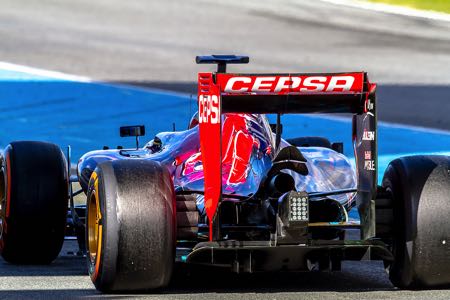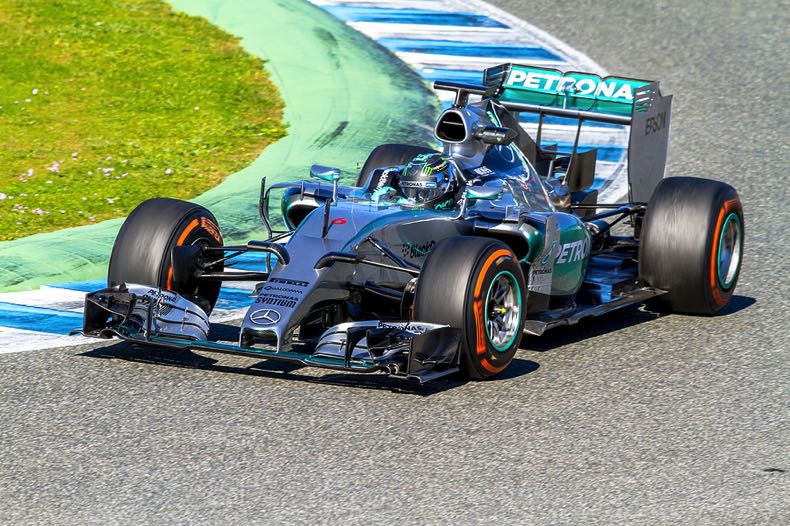
Formula 1 is pretty jargon rich. DRS is one of the newer acronyms to be used in the sport, and we’re going to fully explain what it all means. DRS stands for ‘Drag Reduction System’. The DRS is controversial within the sport. It is a device, controlled by the driver, which aims to enhance overtaking possibilities.
The system allows for drivers to open a flap in the rear wing of the car, reducing drag levels and reaching top speed when they run within a second of the car in front of them. It was first introduced in 2011.
How DRS Works
DRS uses an actuator, which is a simple device to move a flap in the middle of the car’s rear wing. To operate the DRS, F1 drivers can push a button on their steering wheel. This can only be done when they reach a certain, designated part of the track. These are known as DRS activation zones. When the flap is opened, it reduces the surface area of the rear wing and so reduces aerodynamic drag. This leads to an increase in speed of the car over a straight line.
The DRS can be used, in the designated zones, only when a car is within a second of the car ahead. The system can be used any time in qualifying. Using F1’s timing technology, the gaps between cars are measured at certain points on the track before DRS zones. These are the detection points. If a car is measured at one second or below behind the car in front, a signal is sent to the driver meaning he knows that DRS can be used in the zone. After DRS is activated, it remains the case until the driver shuts off the flap when they come off the gas or depress the brake.
Drivers are not obliged to use DRS when running one second behind another car. This remains a choice. The system can also not be used during the opening two laps of the race or after rolling starts (safety car, etc). If a driver is less than one second ahead of another car and vulnerable, they too can use DRS as long as they are also less than one second behind the car in front of them. The criticism here is that modern drivers have become too reliant on technology, rather than honing their attacking and defensive driving skills.
Why Was DRS Introduced to F1?

As we know, DRS is used to aid overtaking in F1. It was brought in primarily to allow easier overtaking. Many people celebrated its advent as some F1 races had become boring, overtaking appearing to be a thing of the past. DRS has often been criticised. The act of simply pressing a button when told you can do so doesn’t scream overtaking skill. It doesn’t even differentiate one constructor from the other, let alone drivers.
We all remember Michael Schumacher taking a different line to other drivers in his pomp, essentially clearing the line for himself in readiness for a later overtake. He was masterful, but now he would be able to simply press a button and almost guarantee an overtake at certain points.
In fairness, it isn’t as simple as that. Though it has been shown to be greatly powerful, drivers need to get close enough to the car in front using their own prowess, while the system simply assists an overtake at a time when drivers would normally be stuck in bad air behind a slower car. Advancements in recent years mean that the dirty air effect isn’t as prevalent. This may lead to DRS being dropped at some point but, for now at least, it remains part of the sport.
Rather than F1 being all about engine grunt, aerodynamics and airflow play a major part in the sport. How that is managed by the teams is a science of which DRS has become part. The problems with dirty air were at their peak around the late 1990s and early 2000s. During this time, some teams would use tactics such as allowing a car further back in the pack which could take over once the car at the front, perhaps a rival, stopped. Fans hated this and it was clear something had to be done.
DRS was introduced in 2011 and was used during F1’s turbo hybrid era. As of 2022 onwards, the sport has reverted to ground effect rules once again because of the effect of dirty air. Rules surrounding engines and fuel are due to change again in 2026, and until then DRS will have a major part to play in the sport.
DRS Zones on the Track
How many DRS zones appear on track will really depend on the location. There is no set number. Essentially, every main straight on a track will feature a DRS zone. If a circuit is notorious for a low number of overtakes, then more zones can be added. While DRS can be used going through corners with shallow angles, to the point of the curves not even being counted as turns by the FIA, it’s usually thought of as unwise for a car to run with a real wing slot open at these times. Not every DRS zone opportunity is taken by drivers.
At these points in a race the reduced drag created by the DRS would increase the car’s top speed, but the reduced downforce would heavily impair control the driver has of the car. This can lead to crashes, meaning DRS zones tend to finish at the end of a long straight. DRS does have its technical problems too. A failure in the system can lead to rear wings being stuck open. When this is the case, drivers can be shown the black with featuring an orange disc.
At this point, drivers are obliged to return to the pit lane where their team can close the flap manually. It can then not be used again if not repaired properly. Drivers may only use their DRS when they are within the pre-agreed activation zones. They must also only use it when within one second of the car in front. The system therefore shouldn’t be overestimated in terms of what effect it has on the sport and, for now, it remains a major part of Formula 1.
